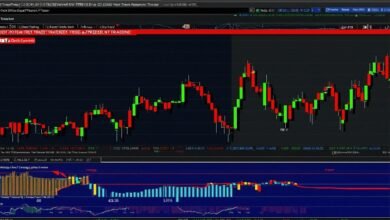Building a Diversified Portfolio with Stocks: A Comprehensive Guide

Introduction
Creating a diversified portfolio with stocks is one of the most effective strategies for managing investment risk while aiming for steady returns. Diversification involves spreading your investments across different stocks to reduce exposure to any single asset or market sector. By building a diversified portfolio with stocks, investors can protect themselves against volatility and downturns in specific industries or companies. In this guide, we will explore the importance of diversification, how to select stocks for a diversified portfolio, and the best practices for maintaining a balanced investment strategy.
Why Diversification Matters in Stock Portfolios
Diversification is a fundamental concept in investing, particularly when it comes to stock portfolios. A diversified portfolio with stocks reduces the risk of significant losses by spreading investments across various sectors, industries, and geographic regions. This approach helps mitigate the impact of poor performance by a single stock or sector. When constructing a diversified portfolio with stocks, investors can achieve a more stable return profile, as the gains in some investments can offset the losses in others. Diversification is not just about owning many stocks; it’s about selecting the right mix of assets to ensure long-term growth and stability.
Key Components of a Diversified Portfolio with Stocks
A well-diversified portfolio with stocks typically includes a mix of large-cap, mid-cap, and small-cap stocks across various industries and sectors. Large-cap stocks provide stability and consistent returns, while mid-cap and small-cap stocks offer higher growth potential. Additionally, a diversified portfolio with stocks should include companies from different sectors, such as technology, healthcare, finance, consumer goods, and energy. Geographic diversification, by including stocks from international markets, can further reduce risk and enhance returns. By combining these elements, investors can build a diversified portfolio with stocks that is resilient to market fluctuations.
Strategies for Selecting Stocks in a Diversified Portfolio
Selecting the right stocks for a diversified portfolio requires a strategic approach. Investors should consider factors such as market capitalization, industry trends, and financial health when choosing stocks. One common strategy is to focus on blue-chip stocks, which are well-established companies with a history of strong performance. Another approach is to include growth stocks, which have the potential for significant appreciation, alongside value stocks, which are undervalued by the market. By blending different types of stocks, investors can create a diversified portfolio with stocks that balances growth potential with risk management.
The Role of Sector Diversification in Stock Portfolios
Sector diversification is a crucial aspect of building a diversified portfolio with stocks. By investing in different sectors, such as technology, healthcare, and energy, investors can reduce the impact of sector-specific risks. For example, if the technology sector experiences a downturn, having investments in other sectors can help cushion the blow. When constructing a diversified portfolio with stocks, it’s important to allocate investments across multiple sectors to ensure that your portfolio is not overly reliant on the performance of any single industry. This approach helps create a balanced portfolio that can weather market changes.
Geographic Diversification in a Stock Portfolio
Geographic diversification involves spreading investments across different countries and regions to reduce exposure to localized risks. A diversified portfolio with stocks should include international equities, as they provide access to growth opportunities in emerging markets and can offer protection against domestic economic downturns. By including stocks from various countries, investors can benefit from global economic trends and reduce the impact of adverse events in any single market. Geographic diversification is a key component of a well-rounded investment strategy, helping to create a diversified portfolio with stocks that is resilient to global market shifts.
The Benefits of Dividend Stocks in a Diversified Portfolio
Dividend stocks play an important role in a diversified portfolio with stocks by providing a steady stream of income and contributing to overall portfolio stability. Companies that pay dividends are often financially stable and have a track record of consistent performance. Including dividend-paying stocks in your portfolio can help offset losses from other investments and provide a cushion during market downturns. Additionally, reinvesting dividends can lead to compounding returns over time. By incorporating dividend stocks into a diversified portfolio, investors can enhance their income potential while maintaining a balanced approach to risk management.
The Importance of Regular Portfolio Rebalancing
Rebalancing is a critical aspect of maintaining a diversified portfolio with stocks. Over time, the value of different assets in a portfolio can change, leading to an imbalance in your original asset allocation. Regular rebalancing involves buying and selling stocks to restore your portfolio to its intended allocation. This process ensures that your portfolio remains diversified and aligned with your investment goals. Rebalancing a diversified portfolio with stocks can help manage risk and optimize returns, ensuring that your investments continue to perform according to your strategy.
The Risks of Over-Diversification
While diversification is essential, it’s possible to over-diversify a portfolio, which can dilute returns and complicate portfolio management. Over-diversification occurs when an investor holds too many stocks, making it difficult to achieve significant gains from any single investment. In a diversified portfolio with stocks, it’s important to strike a balance between having enough diversification to manage risk and maintaining focus on high-quality investments. By carefully selecting stocks and avoiding unnecessary complexity, investors can create a diversified portfolio that maximizes returns without sacrificing manageability.
How to Monitor and Adjust Your Diversified Portfolio
Monitoring and adjusting your diversified portfolio with stocks is essential for long-term success. Investors should regularly review their portfolios to ensure that the asset allocation remains aligned with their investment goals. This involves assessing the performance of individual stocks, sectors, and geographic regions, and making adjustments as needed. Changes in market conditions, economic trends, and personal financial goals may require you to modify your portfolio. By staying proactive and responsive to changes, you can maintain a diversified portfolio with stocks that continues to meet your financial objectives.
The Role of Exchange-Traded Funds (ETFs) in a Diversified Portfolio
Exchange-Traded Funds (ETFs) are an effective tool for achieving diversification in a stock portfolio. ETFs allow investors to gain exposure to a broad range of stocks within a single investment, making it easier to build a diversified portfolio with stocks. Whether focusing on specific sectors, geographic regions, or market indices, ETFs provide a convenient way to diversify without the need to purchase individual stocks. Including ETFs in your portfolio can simplify diversification and provide a cost-effective way to achieve a balanced investment strategy. They are especially useful for investors looking to create a diversified portfolio with stocks without extensive research or management.
Case Studies: Successful Diversified Stock Portfolios
Learning from real-world examples can provide valuable insights into building a diversified portfolio with stocks. Case studies of successful portfolios often highlight the importance of sector and geographic diversification, as well as the benefits of including a mix of large-cap, mid-cap, and small-cap stocks. These examples show how diversified portfolios can withstand market volatility and achieve consistent returns over time. By analyzing these case studies, investors can gain a deeper understanding of how to construct and manage their own diversified portfolio with stocks, applying proven strategies to their investment approach.
Conclusion
In conclusion, building a diversified portfolio with stocks is a critical strategy for managing risk and achieving long-term financial success. By spreading investments across different sectors, industries, and geographic regions, investors can protect themselves against market volatility and enhance their returns. Whether you are new to investing or have years of experience, understanding how to create and maintain a diversified portfolio with stocks is essential. By following the strategies outlined in this guide, you can develop a balanced portfolio that aligns with your financial goals and adapts to changing market conditions.
FAQs
1. What is a diversified portfolio with stocks?
A diversified portfolio with stocks is an investment strategy that involves spreading investments across various stocks, sectors, and geographic regions to reduce risk and enhance returns.
2. Why is diversification important in stock investing?
Diversification is important because it helps reduce the risk of significant losses by spreading investments across different assets, ensuring that poor performance in one area does not heavily impact the entire portfolio.
3. How can I select stocks for a diversified portfolio?
Selecting stocks for a diversified portfolio involves choosing a mix of large-cap, mid-cap, and small-cap stocks from various sectors and geographic regions. Consider factors like market trends, financial health, and growth potential.
4. What are the risks of over-diversification?
Over-diversification can dilute returns and complicate portfolio management by spreading investments too thinly across too many stocks, making it difficult to achieve significant gains from any single investment.
5. How often should I rebalance my diversified portfolio with stocks?
Rebalancing should be done regularly, typically once or twice a year, or whenever there are significant changes in the market or your personal financial goals, to maintain the desired asset allocation and risk level.





